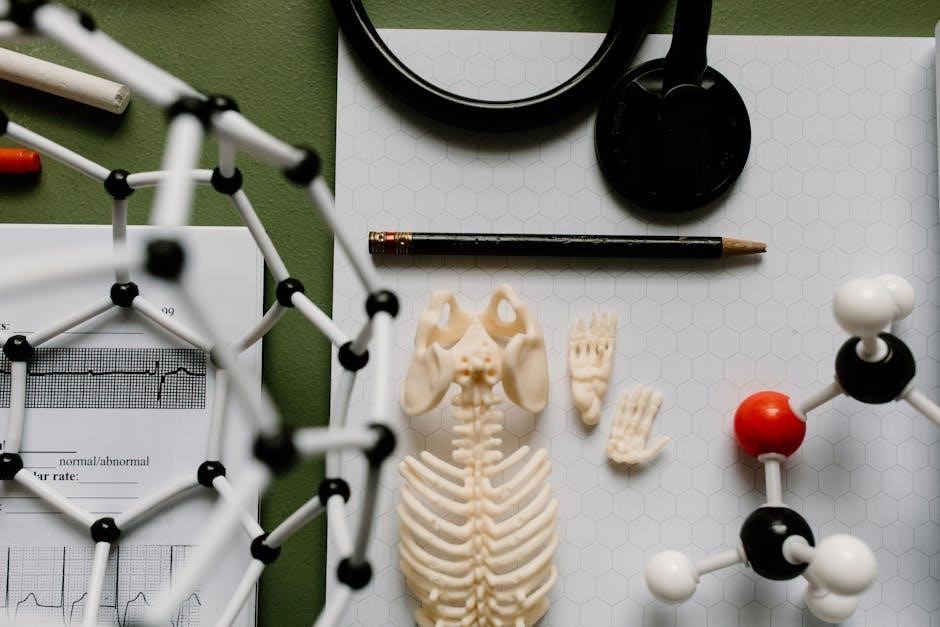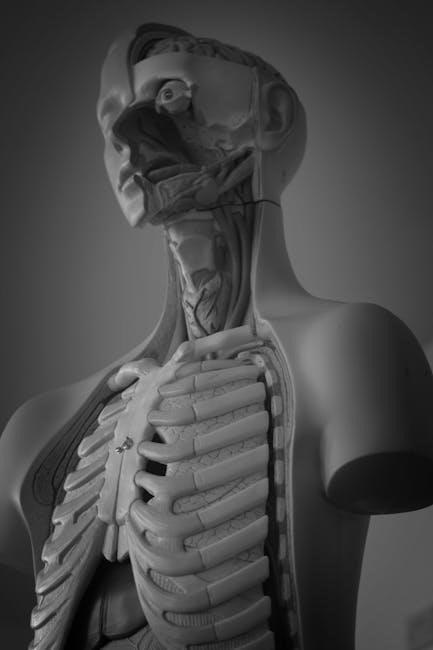Dr. Linda Costanzo’s Physiology PDF offers a clear, logical, and comprehensive overview of core physiologic concepts, ideal for coursework and USMLE preparation, with engaging visuals and step-by-step explanations.
Overview of the Book
Dr. Linda Costanzo’s Physiology PDF is a comprehensive and user-friendly resource that provides a clear understanding of core physiologic concepts. The book is structured logically, covering essential topics at both the organ system and cellular levels. It is designed to simplify complex principles, making it an ideal tool for medical students and professionals preparing for exams like the USMLE. The PDF version ensures easy access and portability, allowing learners to study efficiently. With its concise yet detailed approach, the book has become a trusted companion for those seeking a thorough grasp of physiology. Its organized layout and focus on key mechanisms ensure that readers can navigate the material effortlessly, making it a valuable asset for both coursework and professional development.
Significance of the PDF Version
The PDF version of Costanzo Physiology is highly valued for its portability and accessibility, enabling users to access the content anytime, anywhere. This digital format is particularly advantageous for students who prefer e-learning or need to study on multiple devices. The PDF preserves the book’s clear layout, including well-designed figures and tables, which are crucial for understanding complex physiologic concepts. Additionally, the PDF version is easily searchable, allowing users to quickly locate specific topics or concepts. This feature is especially useful during exam preparation, where time efficiency is key. The convenience and flexibility of the PDF make it a preferred choice among medical students and professionals, ensuring they can engage with the material in a way that suits their learning style and schedule. Its digital accessibility enhances the overall learning experience, making it an indispensable resource in modern medical education.

Structure of the Book
Costanzo Physiology PDF is organized into seven chapters, starting with general cellular principles and progressing through neurophysiology, cardiovascular, respiratory, renal, gastrointestinal, and endocrine systems, ensuring a logical flow.
Chapter 1: General Principles of Cellular Physiology
Chapter 1 of Costanzo Physiology provides a foundational understanding of cellular physiology, covering essential topics such as cell structure, membrane transport mechanisms, ion channels, and cellular signaling pathways. It introduces the principles of homeostasis and the importance of maintaining equilibrium in physiological processes. The chapter also explores cellular energy production, including glycolysis, the citric acid cycle, and oxidative phosphorylation, emphasizing their roles in cellular function. Additionally, it delves into the basics of nerve signaling, action potentials, and synaptic transmission, laying the groundwork for subsequent chapters on neurophysiology. Clear explanations and diagrams help students grasp complex concepts, making this chapter a critical starting point for understanding the physiology of cells and their interactions in the human body.
Chapter 2: Neurophysiology

Chapter 2 of Costanzo Physiology delves into the intricacies of neurophysiology, exploring the functioning of the nervous system, neuronal signaling, and synaptic transmission. It provides detailed explanations of action potentials, resting membrane potentials, and the role of ion channels in generating these electrical signals. The chapter also covers sensory receptors and their responses to stimuli, as well as the mechanisms of neurotransmitter release and receptor binding. Additionally, it examines the integration of neural signals in the central nervous system and the regulation of reflexes. Clear diagrams and step-by-step explanations help students understand the complex processes involved in neural communication. This chapter builds on the foundational concepts introduced in Chapter 1, offering a comprehensive understanding of how the nervous system operates at the cellular and systems levels.
Chapter 3: Cardiovascular Physiology
Chapter 3 of Costanzo Physiology focuses on the cardiovascular system, detailing the mechanisms that regulate blood pressure, cardiac output, and blood flow distribution. It explains the structure and function of the heart, blood vessels, and blood, emphasizing the interplay between neural and hormonal controls. The chapter covers key concepts such as stroke volume, vascular resistance, and the Frank-Starling mechanism, providing clear step-by-step explanations. Visual aids, including diagrams of the cardiovascular system and pressure-volume loops, enhance understanding. Additionally, the chapter discusses pathophysiological conditions like hypertension and heart failure, linking basic physiology to clinical scenarios. Dr. Costanzo’s logical organization and concise writing style make this chapter an invaluable resource for students mastering cardiovascular physiology for coursework and exams.

Chapter 4: Respiratory Physiology
Chapter 4 of Costanzo Physiology delves into the intricacies of respiratory physiology, providing a detailed exploration of how the respiratory system maintains gas exchange and homeostasis. The chapter begins with the basics of ventilation, including lung mechanics and the regulation of breathing, before moving on to advanced topics like gas exchange at the alveolar-capillary interface. Dr. Costanzo explains concepts such as partial pressures, diffusion capacity, and the role of surfactant in reducing surface tension. The chapter also covers the neural control of respiration, highlighting the roles of the medulla and pons, as well as the influence of chemoreceptors. Visual aids, such as pressure-volume loops and diagrams of the respiratory tree, complement the text. Additionally, the chapter addresses pathophysiological conditions, including respiratory distress syndrome and compensatory bronchiolar constriction, offering a clinical perspective on respiratory physiology.
Chapter 5: Renal Physiology

Chapter 5 of Costanzo Physiology focuses on renal physiology, providing a thorough understanding of kidney function and its role in maintaining homeostasis. The chapter begins with the basics of glomerular filtration and renal blood flow, explaining how the kidneys regulate electrolytes, water, and acid-base balance. Dr. Costanzo offers a detailed explanation of the nephron’s structure and function, including tubular reabsorption and secretion. The chapter also covers the renin-angiotensin-aldosterone system and its significance in blood pressure regulation. New additions include discussions on the renal handling of uric acid and its implications in disease states. Visual aids, such as diagrams of the nephron and tables summarizing electrolyte transport mechanisms, enhance comprehension. The chapter concludes with a focus on clinical correlations, making it an invaluable resource for understanding both normal and pathological renal function.
Chapter 6: Gastrointestinal Physiology

Chapter 6 of Costanzo Physiology delves into the intricacies of the gastrointestinal (GI) system, exploring its role in digestion, absorption, and nutrient utilization. The chapter begins with an overview of the digestive process, emphasizing the functions of the mouth, esophagus, stomach, small intestine, and large intestine. Dr. Costanzo explains the mechanisms of gastric motility and the secretion of digestive enzymes, highlighting their importance in breaking down food into absorbable nutrients. The chapter also covers the physiology of absorption, including the role of transport proteins and the enteric nervous system. New content includes discussions on compensatory mechanisms in GI physiology and their clinical implications. Visual aids, such as diagrams of the GI tract and tables detailing nutrient absorption sites, enhance understanding. This chapter provides a robust foundation for comprehending both normal and pathological GI functions.
Chapter 7: Endocrine Physiology
Chapter 7 of Costanzo Physiology explores the intricate functions of the endocrine system, focusing on hormone regulation and its impact on bodily functions. Dr. Costanzo provides a detailed overview of key endocrine glands, including the pancreas, thyroid, adrenal glands, and pituitary gland, explaining their roles in metabolism, growth, and electrolyte balance. The chapter emphasizes the importance of feedback mechanisms in maintaining hormonal homeostasis and discusses the clinical relevance of hormonal imbalances. Visual aids, such as flowcharts illustrating hormone pathways and tables summarizing endocrine disorders, enhance comprehension. This chapter offers a clear, logical approach to understanding the endocrine system, making it an essential resource for students and professionals alike. The PDF version ensures easy access to diagrams and text, facilitating effective study and review.

Key Features of Costanzo Physiology
Dr. Linda Costanzo’s Physiology PDF is renowned for its clear, logical writing style, well-designed visual aids, and step-by-step explanations, making complex concepts accessible and easy to understand.
Clear and Logical Writing Style
Dr. Linda Costanzo’s Physiology PDF is widely praised for its clear and logical writing style, which simplifies complex physiological concepts into easily digestible content; The text avoids overly technical language, ensuring accessibility for students at all levels. Each topic is presented in a structured, step-by-step manner, making it easier to follow and understand. The author’s friendly tone and logical organization foster a deep comprehension of physiology, particularly for those preparing for exams like the USMLE. This clarity is especially beneficial for visual learners, as the PDF format retains the book’s well-designed figures and tables, providing a seamless learning experience. The combination of clear writing and logical flow ensures that students can grasp even the most challenging topics with confidence.
Visual Aids and Diagrams
The Costanzo Physiology PDF is enriched with well-designed visual aids and diagrams that complement the text, making complex physiological concepts more accessible. These visuals include detailed illustrations, flowcharts, and tables that break down intricate processes into manageable parts. For instance, diagrams of cellular mechanisms and organ systems provide a clear understanding of how different components interact. The PDF format ensures that these visuals remain crisp and vibrant, enhancing the learning experience. Students can easily refer to these diagrams while studying, which helps reinforce key concepts. The combination of visual and textual information creates a comprehensive resource that caters to both visual and textual learners, making it an invaluable tool for coursework and exam preparation, such as the USMLE.
Step-by-Step Explanations
Costanzo Physiology PDF excels in providing step-by-step explanations that simplify complex physiological processes, making them easier to grasp. Each concept is broken down into logical sequences, guiding students through challenging topics systematically. For example, explanations of neurophysiological pathways or cardiovascular mechanisms are presented in a clear, methodical manner. This approach helps students build a strong foundation and understand how different components interact within the body. The PDF format ensures that these explanations are accessible and easy to navigate, allowing for efficient study sessions. Dr. Costanzo’s structured breakdown of information is particularly beneficial for students preparing for exams like the USMLE, as it aids in both understanding and retention of key physiological principles.

New Coverage in the Latest Edition
The latest edition includes new topics like SARS-CoV-2 physiology, renal handling of uric acid, delta/delta analysis, endolymph physiology, respiratory distress syndrome, and compensatory bronchiolar constriction.
SARS-CoV-2 Physiology
The latest edition of Costanzo Physiology includes a detailed exploration of SARS-CoV-2 physiology, focusing on its impact on respiratory and cardiovascular systems. It examines how the virus disrupts normal cellular functions, particularly in alveolar epithelial cells, leading to impaired gas exchange and acute respiratory distress. The section also delves into the systemic inflammation caused by cytokine storms and the long-term effects of COVID-19 on various organ systems. Additionally, it discusses the mechanisms of viral entry, including the role of ACE2 receptors, and the physiological changes that contribute to complications such as thrombosis and multi-organ failure. This coverage provides essential insights into the pathophysiology of SARS-CoV-2, making it a valuable resource for understanding the clinical manifestations of COVID-19.
Renal Handling of Uric Acid
The renal handling of uric acid is a critical process for maintaining proper nitrogenous waste excretion and acid-base balance. The kidneys filter uric acid, a byproduct of purine metabolism, and regulate its excretion based on the body’s needs. Uric acid is primarily excreted in the urine, but its reabsorption and secretion are tightly controlled by renal tubular mechanisms. This process ensures proper uric acid levels in the blood, preventing conditions like hyperuricemia, which can lead to gout or kidney stones. Costanzo Physiology provides a detailed explanation of how the kidneys manage uric acid, including the role of transport proteins and the influence of factors like diet, medications, and pathological conditions. Understanding this process is essential for grasping renal physiology and its clinical implications, making it a key topic in the book.
Delta/Delta Analysis in Acid-Base Physiology
Delta/Delta analysis is a powerful tool in acid-base physiology for understanding complex disturbances. It involves comparing changes in bicarbonate (HCO3-) and chloride (Cl-) levels to identify mixed acid-base disorders. This method helps differentiate between respiratory and metabolic contributions to acid-base imbalances. By analyzing the delta (change) in HCO3- and Cl-, clinicians can determine whether a disorder is simple or mixed. Costanzo Physiology explains how Delta/Delta analysis provides a clearer picture of acid-base physiology, making it easier to diagnose and manage conditions like metabolic acidosis or alkalosis. This approach is particularly useful in critical care settings where precise interpretations are crucial. The book emphasizes the practical application of Delta/Delta analysis, ensuring students and healthcare professionals grasp its importance in clinical decision-making. This section is a valuable resource for mastering acid-base physiology, a cornerstone of medical education and practice.

Endolymph Physiology
Endolymph physiology, as covered in Costanzo Physiology, focuses on the unique fluid within the inner ear’s membranous labyrinth. This fluid is crucial for maintaining the ionic environment necessary for sensory hair cell function. Unlike other bodily fluids, endolymph has a high concentration of potassium ions (K+) and low sodium ions (Na+), which is essential for the proper functioning of the vestibular and auditory systems. The regulation of endolymph composition involves specialized ion transport mechanisms in the epithelial cells lining the endolymphatic sac and duct. Disruptions in this balance can lead to disorders such as Ménière’s disease, characterized by vertigo, hearing loss, and tinnitus. Costanzo Physiology provides a detailed explanation of endolymph production, regulation, and its role in maintaining equilibrium and hearing. This section is vital for understanding the intricate mechanisms of inner ear physiology and their clinical implications.
Respiratory Distress Syndrome
Respiratory Distress Syndrome (RDS), as discussed in Costanzo Physiology, primarily affects preterm infants due to surfactant deficiency in the lungs. Surfactant reduces alveolar surface tension, preventing collapse during exhalation. Without it, lungs stiffen, leading to difficulty in expanding alveoli and maintaining oxygenation. This results in hypoxemia, hypercapnia, and respiratory failure. The pathophysiology involves impaired gas exchange, increased work of breathing, and potential long-term pulmonary complications. Costanzo Physiology explains the clinical manifestations, including tachypnea, retractions, and crackles on lung auscultation. Diagnostic criteria often include chest X-rays showing characteristic ground-glass opacification. Management strategies, such as exogenous surfactant administration and mechanical ventilation, are also covered. The book provides a clear, concise understanding of RDS, making it an invaluable resource for students and clinicians alike. Its comprehensive approach ensures that learners grasp both the underlying mechanisms and clinical interventions effectively.
Compensatory Bronchiolar Constriction

Compensatory bronchiolar constriction, discussed in Costanzo Physiology, is a reflex mechanism that helps regulate airflow and maintain proper gas exchange in the lungs. This response occurs when certain stimuli, such as irritants or inflammatory mediators, activate sensory receptors in the airway epithelium. The efferent signals from these receptors trigger the contraction of smooth muscle surrounding the bronchioles, leading to a narrowing of the airway lumen. While this mechanism can protect the lungs by limiting the entry of harmful substances, excessive or inappropriate constriction can impede airflow, increasing airway resistance and making breathing more difficult. Costanzo Physiology provides a detailed explanation of this process, emphasizing its role in both normal physiology and pathological conditions like asthma or chronic bronchitis. The book’s clear, logical presentation helps students grasp the underlying mechanisms and their clinical implications.




